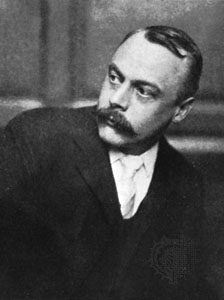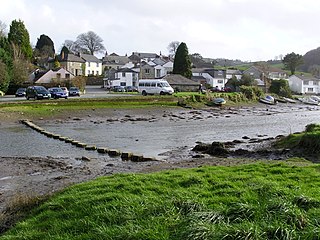
The Wind in the Willows is a children's book by Scottish novelist Kenneth Grahame, first published in 1908. Alternatingly slow moving and fast paced, it focuses on four anthropomorphised animals: Mole, Rat, Toad, and Badger. They live in a pastoral version of Edwardian England.

Kenneth Grahame was a British writer born in Edinburgh, Scotland, to a Scottish family. He is most famous for The Wind in the Willows (1908), one of the classics of children's literature. He also wrote The Reluctant Dragon. Both books were later adapted for stage and film, of which A. A. Milne's Toad of Toad Hall, based on part of The Wind in the Willows, was the first. Other adaptations include the Disney films The Adventures of Ichabod and Mr. Toad and The Reluctant Dragon.

Mapledurham Lock is a lock and weir situated on the River Thames in England. The lock was first built in 1777 by the Thames Navigation Commissioners and the present lock dates from 1908.

Hardwick Hall in Derbyshire, is an architecturally significant Elizabethan country house in England, a leading example of the Elizabethan prodigy house. Built between 1590 and 1597 for the formidable Bess of Hardwick, it was designed by the architect Robert Smythson, an exponent of the Renaissance style of architecture. Hardwick Hall is one of the earliest examples of the English interpretation of this style, which came into fashion having slowly spread from Florence. Its arrival in Britain coincided with the period when it was no longer necessary or legal to fortify a domestic dwelling. Ownership of the house was transferred to the National Trust in 1959. It is fully open to the public and received 298,283 visitors in 2019.

Fawley Court is a country house, with large mixed-use grounds standing on the west bank of the River Thames at Fawley in the English county of Buckinghamshire. Its former deer park extended east into the Henley Park area of Henley-on-Thames, Oxfordshire that abuts it to the south. Following World War II, it was run as Divine Mercy College by the Polish Congregation of Marian Fathers, with its associated library, museum and was one of the cultural centres for the Polish minority in the United Kingdom until its closure and sale in the 2009. It is listed at Grade I for its architecture.

Mapledurham is a small village, civil parish and country estate beside the River Thames in southern Oxfordshire. The large parish borders Caversham the most affluent major district of Reading, Berkshire. All buildings in the village have traditional, rural and/or picturesque views. Significant historic buildings include the Church of England parish church of St. Margaret, Mapledurham Watermill and Mapledurham House.

Lerryn is a village in Cornwall, United Kingdom. It is situated on the River Lerryn approximately three miles (5 km) southeast of Lostwithiel.

There have been four baronetcies created for persons with the surname Rose, all in the Baronetage of the United Kingdom. Three of the creations are extant as of 2010.
Sir Charles Augustin Hanson, 1st Baronet of Fowey was a British politician and 590th Lord Mayor of London.

Mapledurham House is an Elizabethan stately home located in the civil parish of Mapledurham in the English county of Oxfordshire. It is a Grade I listed building, first listed on 24 October 1951.
The High Sheriff of Oxfordshire, in common with other counties, was originally the King's representative on taxation upholding the law in Saxon times. The word Sheriff evolved from 'shire-reeve'.

Henley Park is a country house and landscape garden in Bix and Assendon civil parish in the Chiltern Hills of South Oxfordshire, England. The house is about 1.5 miles (2.4 km) north of Henley-on-Thames. The park adjoins the county boundary with Buckinghamshire.

Menabilly is a historic estate on the south coast of Cornwall, England, situated within the parish of Tywardreath on the Gribben peninsula about 2 miles (3.2 km) west of Fowey.

Sir Charles Day Rose, 1st Baronet was a British-Canadian businessman, race horse breeder, yachtsman, and Liberal politician.

Philip Lybbe Powys Lybbe was an English rower, barrister and Conservative politician who sat in the House of Commons between 1859 and 1865.

Foxwarren Park, at Wisley in Surrey, is a Victorian country house and estate. On sandstone Ockham and Wisley Commons, it was designed in 1860 by the railway architect Frederick Barnes for brewing magnate and MP, Charles Buxton. It is a Grade II* listed building.

Cowick Hall is a 17th-century Georgian country house in the town of Snaith, located between the villages of East and West Cowick, in the East Riding of Yorkshire, England. The house is Grade I listed and several outbuildings on the estate are Grade II listed. Once home to the Viscounts Downe, today it serves as the corporate headquarters of chemical company Croda International.

Toad Hall is the fictional home of Mr. Toad, a character in the 1908 novel ‘The Wind in the Willows’ by Kenneth Grahame.
Whitchurch Rural is a civil parish in Shropshire, England. It contains 15 listed buildings that are recorded in the National Heritage List for England. Of these, two are listed at Grade II*, the middle of the three grades, and the others are at Grade II, the lowest grade. The parish is to the south and east of the town of Whitchurch, and contains a number of villages and smaller settlements, including Alkington, and is otherwise rural. The listed buildings consist of houses and farmhouses, two churches, and a pair of limekilns.
Whitchurch Urban is a civil parish in Shropshire, England. It contains 110 listed buildings that are recorded in the National Heritage List for England. Of these, one is listed at Grade I, the highest of the three grades, seven are at Grade II*, the middle grade, and the others are at Grade II, the lowest grade. The parish contains the market town of Whitchurch and areas to the north, west and east of the town. Most of the listed buildings are in the town, and a high proportion are houses, shops, and public houses, the earliest of which are timber framed or have a timber framed core. The other listed buildings in the town include churches, items in a churchyard, a country house, almshouses, a bank, offices, schools, hotels, a drinking fountain, and a war memorial. Outside the town are farmhouses, a boundary stone, a milestone, and a road bridge. The Llangollen Canal runs through the western part of the parish, and the listed buildings associated with it are a lock keeper's cottage and a lift bridge.


















